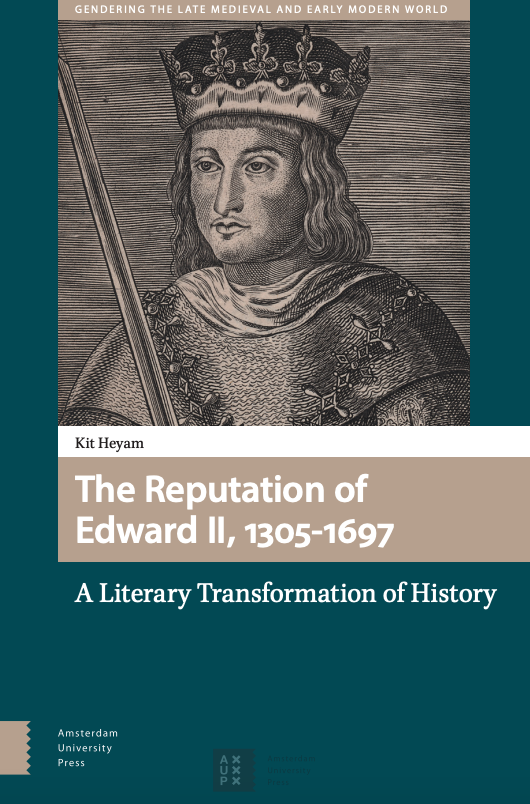Kit Heyam
During his lifetime and the four centuries following his death, King Edward II (1307-1327) acquired a reputation for having engaged in sexual and romantic relationships with his male favourites, and having been murdered by penetration with a red-hot spit. The Reputation of Edward II, 1305-1697: A Literary Transformation of History provides the first full account of how this reputation developed, providing new insights into the processes and priorities that shaped narratives of sexual transgression in medieval and early modern England. Through close readings of poetry and drama, alongside chronicle accounts and political pamphlets, it demonstrates that Edward’s medieval and early modern afterlife was significantly shaped by the influence of literary texts and techniques.

NOTCHES: In a few sentences, what is your book about?
Kit Heyam: The book is the first full account of how King Edward II (1307-1327) got his queer reputation: the story of the development, over the period 1305-1697, of a consensus that Edward’s relationships with his male favourites were sexual and romantic, and that he was murdered by anal penetration with a red-hot spit. In telling this story, the book also discusses the development of sexual discourse in England over this period; the distinction that medieval and early modern writers made between same-sex love and same-sex desire; and the use of Edward II as a political exemplum, both in terms of his favourites and in terms of his deposition. It also provides some new perspectives on key literary accounts of his reign, particularly Christopher Marlowe’s play Edward II (c. 1591-92).
NOTCHES: What do we actually know about the sexuality of Edward II? What (if anything) was he accused of in his lifetime?
KH: Most accounts of Edward’s reign written during his lifetime describe his love for his favourites, particularly Piers Gaveston, as excessive. He was also accused of ‘lechery’ (in a text known as The Prophecy of the Six Kings) and of adultery (in a continuation to the chronicle Flores Historiarum, written by the monk Robert of Reading) – so we know that at least some of his subjects thought he was sexually transgressive. We’ll never know for certain whether these opinions were justified, or whether they were intended – or read – as indicating sex with men or with women. For me, it was important when writing this book not to get bogged down in establishing the ‘facts’ of Edward II’s sexual behaviour: it’s an unanswerable question, and in any case, what most people throughout history have ‘known’ about Edward II has been based on his textual reputation, not on whatever he might actually have been doing sexually. By looking at his reputation instead, we can answer a lot more interesting questions about how narratives of sexual transgression were constructed.
NOTCHES: How was his sexual reputation reshaped after his death, and why?
KH: Accusations of Edward’s sexual transgression gradually increased in frequency and clarity. By the late sixteenth century, chroniclers like Raphael Holinshed were writing that Edward’s sexual transgressions were encouraged by his favourites – but they didn’t quite ‘join the dots’ to state explicitly that those sexual transgressions constituted having sex with his favourites. The turning point was Christopher Marlowe’s Edward II, which was the first text to explicitly present Edward and Gaveston’s relationship as romantic and sexual, and which had a significant impact on later texts of all genres.
By the mid-to-late fourteenth century, a consensus also took hold that Edward had been murdered by anal penetration with a red-hot spit. This story has, understandably, often been interpreted as being a kind of punitive, sexually mimetic murder method. But as I argue in the book, it’s important to realise that the penetrative murder narrative emerges at a point where the historiographical consensus that Edward’s transgressions were sexual at all – let alone that they specifically constituted sex with his male favourites – was very much still emerging. As I wrote in an earlier Notches post, early accounts of this murder method are often more about sympathy and less about sex than we’ve often assumed.
NOTCHES: Why was the story of Edward II so intriguing to early modern writers such as Christopher Marlowe?
KH: As well as being a good story – one which combined a king’s sensational, outrage-provoking sexual and political misbehaviour with his tragic fall – the story of Edward II’s reign felt urgently politically relevant to early modern writers. Both Elizabeth I and James VI/I had favourites who were perceived to be excessively powerful, and were subject to rumours about their sexual involvement with the monarch: favourites were even more dangerous when they could use their sexual attractiveness for political gain. So Edward II provided the perfect parallel – both for writers of political pamphlets, and for writers of chronicles and literary texts who just wanted to hook their readers with a contemporary political allusion.
NOTCHES: Your book is about Edward II, but also about his alleged lovers, especially Piers Gaveston. Were these men, or their relationships with the king, ever portrayed in a positive light?
KH: One of the findings I least expected was the lengths that medieval and early modern writers go to present Edward and Gaveston’s relationship as an emotionally compelling, tragic love story. As well as writing sensationalised condemnations of Edward’s relationship with Gaveston (and with the two Hugh Despensers), particularly on the basis of his favourites’ excessive political influence, writers romanticised Edward’s relationship with Gaveston: they altered their sources to align their accounts of Edward and Gaveston with the tropes of romance, thereby increasing the pathos that their readers feel for the two men’s separation through Gaveston’s exiles and ultimate death. These positive portrayals of their romantic relationship don’t mean that their sexual relationship is condoned: on the contrary, writers often combine this tragic love story with sensational accounts of Edward’s sexual sin, creating a story with maximum reader engagement. But it does mean that the historiography of Edward II and Piers Gaveston represents an underacknowledged source of positive depictions of relationships between men, which I think is politically as well as academically important.
NOTCHES: Your book is strongly interdisciplinary, using literary sources and methodologies as well as historical texts and approaches. How has this approach shaped this project, and do you think this is something that historians of sexuality could/ should do more of?
KH: I hope the book’s interdisciplinary approach might prompt both historians and literary critics to think again about the boundaries between our disciplines. On a small scale, I found close textual analysis really useful in thinking about the way that individual writers encourage their readers to interpret the very often ambiguous terms that constitute medieval and early modern sexual discourse. On a wider scale, the overarching story of the book is the story of how all the most significant developments in the construction of Edward II’s sexual reputation were the result of the impact of literary texts like Marlowe’s Edward II, and of literary decisions made by writers of all genres: when shaping their accounts of Edward’s reign, writers overwhelmingly prioritised narrative structure and readers’ emotional engagement over evaluating their sources’ factual accuracy. If we want to think fully about the way that narratives of sexual transgression were constructed, I’d argue that we need to take these literary motivations into account.
NOTCHES: How do you see your book being used in the classroom, and what would you assign it with?
KH: The book is a case study of how queer reputations were constructed in medieval and early modern England, and as such it might find a home on courses about the history of sexuality and gender, alongside other case studies such as those found in Tom Linkinen’s Same-Sex Sexuality in Later Medieval English Culture, Katherine Crawford’s article ‘Love, Sodomy, and Scandal: Controlling the Sexual Reputation of Henry III’, and Harry Cocks’s Visions of Sodom: Religion, Homoerotic Desire, and the End of the World in England, c. 1550–1850. It’s also potentially a good source for courses about the history of favouritism and/or the use of historical examples in early modern political culture, particularly the public reputations of Elizabeth I and James VI/I; and for introductory courses that encourage students to think critically about genre and the relationship between history and literature. And I hope anyone teaching Marlowe’s Edward II might find the book useful for thinking about the play’s impact and significance, Marlowe’s engagement with his sources, and what happens in the scene where Edward is murdered; in that respect it might make a good companion to the recent Arden Critical Reader on Edward II, edited by Kirk Melnikoff.
NOTCHES: Why does the sex life and/ or the posthumous sexual reputation of a medieval king matter today?
KH: I’ve long been convinced of the political value of diversifying our accounts of queer history – both to provide important points of connection for contemporary queer people, and to combat arguments which use the rhetoric of ‘tradition’ to undermine the struggle for queer rights by denying our historicity. I also think that what the book reveals about the role of literary ‘storytelling’ in the development of Edward’s sexual reputation matters not only academically (as I’ve said above) but also for how we understand the ‘truth’ of sensational accounts of contemporary events: it’s crucial to be aware of the way that even news articles we trust are always constructing their stories as literary accounts.
NOTCHES: What are you working on now that your book is published?
KH: Reading accounts of Edward II’s sexual transgressions in early modern chronicles led me to think about the diverse contexts and genres in which early modern readers must have encountered sexual content. My new project, ‘Reading Sexual Content in Early Modern English Print’, investigates how this content was framed by writers, printers and publishers – and engaged with by readers – in books that aren’t framed as erotica, including chronicles alongside medical books, travel writing, political texts, poetry and romance. Alongside this, I’ve been continuing to work on the public representation of queer history: thinking about memorialisation through the #RainbowPlaques project, and writing on how we represent the ‘difficult’ trans histories of people who have multiple possible motivations for gender nonconformity.
 Kit Heyam is a Lecturer in English at Northumbria University, a trans awareness trainer, and a queer history activist. Their work focuses on sexual and gendered transgression in late medieval and early modern literature and culture, and they have broader research interests in methodological approaches to difficult or ambiguous queer histories and in queer memorialisation. They coordinate the #RainbowPlaques project and are an organiser of Leeds Queer Film Festival. They tweet from @krheyam.
Kit Heyam is a Lecturer in English at Northumbria University, a trans awareness trainer, and a queer history activist. Their work focuses on sexual and gendered transgression in late medieval and early modern literature and culture, and they have broader research interests in methodological approaches to difficult or ambiguous queer histories and in queer memorialisation. They coordinate the #RainbowPlaques project and are an organiser of Leeds Queer Film Festival. They tweet from @krheyam.

NOTCHES: (re)marks on the history of sexuality is licensed under a Creative Commons Attribution-NonCommercial-NoDerivatives 4.0 International License.
Based on a work at www.notchesblog.com.
For permission to publish any NOTCHES post in whole or in part please contact the editors at NotchesBlog@gmail.com




